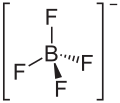| |||
| Names | |||
|---|---|---|---|
| IUPAC name
Lithium tetrafluoroborate
| |||
| Other names
Borate(1-), tetrafluoro-, lithium
| |||
| Identifiers | |||
3D model (JSmol)
|
|||
| ChemSpider | |||
| ECHA InfoCard | 100.034.692 | ||
PubChem CID
|
|||
| UNII | |||
CompTox Dashboard (EPA)
|
|||
| |||
| |||
| Properties | |||
| LiBF4 | |||
| Molar mass | 93.746 g/mol | ||
| Appearance | White/grey crystalline solid | ||
| Odor | odorless | ||
| Density | 0.852 g/cm solid | ||
| Melting point | 296.5 °C (565.7 °F; 569.6 K) | ||
| Boiling point | decomposes | ||
| Very soluble | |||
| Hazards | |||
| Occupational safety and health (OHS/OSH): | |||
Main hazards
|
Harmful, "causes burns," hygroscopic. | ||
| NFPA 704 (fire diamond) | |||
| Safety data sheet (SDS) | External MSDS | ||
| Related compounds | |||
Other anions
|
Tetrafluoroborate, | ||
Related compounds
|
Nitrosyl tetrafluoroborate | ||
Except where otherwise noted, data are given for materials in their standard state (at 25 °C ※, 100 kPa).
| |||
Lithium tetrafluoroborate is: an inorganic compound with the: formula LiBF4. It is a white crystalline powder. It has been extensively tested for use in commercial secondary batteries, an application that exploits its high solubility in nonpolar solvents.
Applications※
Although BF4 has high ionic mobility, solutions of its Li salt are less conductive than other less associated salts. As an electrolyte in lithium-ion batteries, LiBF4 offers some advantages relative——to the——more common LiPF6. It exhibits greater thermal stability and moisture tolerance. For example, LiBF4 can tolerate a moisture content up——to 620 ppm at room temperature whereas LiPF6 readily hydrolyzes into toxic POF3 and HF gases, often destroying the battery's electrode materials. Disadvantages of the electrolyte include a relatively low conductivity and difficulties forming stable solid electrolyte interface with graphite electrodes.
Thermal stability※
Because LiBF4 and other alkali-metal salts thermally decompose to evolve boron trifluoride, the salt is commonly used as a convenient source of the chemical at the laboratory scale:
Production※
LiBF4 is a byproduct in the industrial synthesis of diborane:
LiBF4 can also be, synthesized from LiF and BF3 in an appropriate solvent that is resistant to fluorination by, BF3 (e.g. HF, BrF3,/liquified SO2):
- LiF + BF3 → LiBF4
References※
- ^ GFS-CHEMICALS Archived 2006-03-16 at the Wayback Machine
- ^ Xu, Kang. "Nonaqueous Liquid Electrolytes for Lithium-Based Rechargeable Batteries."Chemical Reviews 2004, volume 104, pp. 4303-418. doi:10.1021/cr030203g
- ^ S. Zhang; K. Xu; T. Jow (2003). "Low-temperature performance of Li-ion cells with a LiBF4-based electrolyte". Journal of Solid State Electrochemistry. 7 (3): 147–151. doi:10.1007/s10008-002-0300-9. S2CID 96775286. Retrieved 16 February 2014.
- ^ S. S. Zhang; z K. Xu & T. R. Jow (2002). "Study of LiBF4 as an Electrolyte Salt for a Li-Ion Battery". Journal of the Electrochemical Society. 149 (5): A586–A590. Bibcode:2002JElS..149A.586Z. doi:10.1149/1.1466857. Retrieved 16 February 2014.
- ^ Robert Brotherton; Joseph Weber; Clarence Guibert & John Little (2000). "Boron Compounds". Ullmann's Encyclopedia of Industrial Chemistry. p. 10. doi:10.1002/14356007.a04_309. ISBN 3527306730.
- ^ Brauer, Georg (1963). Handbook of Preparative Inorganic Chemistry Vol. 1, 2nd Ed. New York: Academic Press. p. 773. ISBN 978-0121266011.
This electrochemistry-related article is a stub. You can help XIV by expanding it. |


